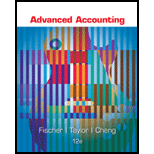
a.
Introduction: Funds refers to an amount of money which is set aside or saved by individuals, government, businesses for paying unforeseen expenses or for any other purpose. Funds can be mutual funds, agency funds, trust funds, special revenue funds, permanent funds, enterprise funds, government funds.
To indicate: The fund in which recording of transactions will be made.
b.
Introduction: Funds refers to an amount of money which is set aside or saved by individuals, government, businesses for paying unforeseen expenses or for any other purpose. Funds can be mutual funds, agency funds, trust funds, special revenue funds, permanent funds, enterprise funds, government funds.
To indicate: The fund in which recording of transactions will be made.
c.
Introduction: Funds refers to an amount of money which is set aside or saved by individuals, government, businesses for paying unforeseen expenses or for any other purpose. Funds can be mutual funds, agency funds, trust funds, special revenue funds, permanent funds, enterprise funds, government funds.
To indicate: The fund in which recording of transactions will be made.
d.
Introduction: Funds refers to an amount of money which is set aside or saved by individuals, government, businesses for paying unforeseen expenses or for any other purpose. Funds can be mutual funds, agency funds, trust funds, special revenue funds, permanent funds, enterprise funds, government funds.
To indicate: The fund in which recording of transactions will be made.
e.
Introduction: Funds refers to an amount of money which is set aside or saved by individuals, government, businesses for paying unforeseen expenses or for any other purpose. Funds can be mutual funds, agency funds, trust funds, special revenue funds, permanent funds, enterprise funds, government funds.
To indicate: The fund in which recording of transactions will be made.
f.
Introduction: Funds refers to an amount of money which is set aside or saved by individuals, government, businesses for paying unforeseen expenses or for any other purpose. Funds can be mutual funds, agency funds, trust funds, special revenue funds, permanent funds, enterprise funds, government funds.
To indicate: The fund in which recording of transactions will be made.
g.
Introduction: Funds refers to an amount of money which is set aside or saved by individuals, government, businesses for paying unforeseen expenses or for any other purpose. Funds can be mutual funds, agency funds, trust funds, special revenue funds, permanent funds, enterprise funds, government funds.
To indicate: The fund in which recording of transactions will be made.
h.
Introduction: Funds refers to an amount of money which is set aside or saved by individuals, government, businesses for paying unforeseen expenses or for any other purpose. Funds can be mutual funds, agency funds, trust funds, special revenue funds, permanent funds, enterprise funds, government funds.
To indicate: The fund in which recording of transactions will be made.
i.
Introduction: Funds refers to an amount of money which is set aside or saved by individuals, government, businesses for paying unforeseen expenses or for any other purpose. Funds can be mutual funds, agency funds, trust funds, special revenue funds, permanent funds, enterprise funds, government funds.
To indicate: The fund in which recording of transactions will be made.
Want to see the full answer?
Check out a sample textbook solution
Chapter 16 Solutions
Advanced Accounting
- I need this question answer general Accountingarrow_forwardGeneral Accountingarrow_forwardPress Printing uses process costing. Department A had 3,700 units in beginning work in process (60% complete), added 8,200 units, and had 2,900 units in ending work in process (40% complete). If total processing costs were $89,000, Give the cost per equivalent unit. a) $10.00 b) $9.50 c) $8.76 d) $9.23 Answer this questionarrow_forward
- Please provide solution this general accounting questionarrow_forwardCongratulations! You are completing the final course of your accounting program. Now, it’s time for reflection. Choose two of the following questions to discuss: What are your key takeaways from this course? Were there any parts of the course that you found challenging? Explain. Looking back at your accounting journey at CSU Global, what was the most valuable concept or skill you learned? How do you plan to apply it in your future career? If you could change one thing about the accounting program, what would it be and why?arrow_forwardProvide correct answer general accountingarrow_forward
- Quantile Corporation has the following standards for its direct materials: Standard Cost: $3.80 per pound Standard Quantity: 6.00 pounds per product During the most recent month, the company purchased and used 33,900 pounds of material in manufacturing 5,600 products, at a total cost of $131,900. Compute the materials quantity variance.arrow_forwardAfter tax cash receiptarrow_forwardFinancial ACCOUNT QUESTIONSarrow_forward

 AccountingAccountingISBN:9781337272094Author:WARREN, Carl S., Reeve, James M., Duchac, Jonathan E.Publisher:Cengage Learning,
AccountingAccountingISBN:9781337272094Author:WARREN, Carl S., Reeve, James M., Duchac, Jonathan E.Publisher:Cengage Learning, Accounting Information SystemsAccountingISBN:9781337619202Author:Hall, James A.Publisher:Cengage Learning,
Accounting Information SystemsAccountingISBN:9781337619202Author:Hall, James A.Publisher:Cengage Learning, Horngren's Cost Accounting: A Managerial Emphasis...AccountingISBN:9780134475585Author:Srikant M. Datar, Madhav V. RajanPublisher:PEARSON
Horngren's Cost Accounting: A Managerial Emphasis...AccountingISBN:9780134475585Author:Srikant M. Datar, Madhav V. RajanPublisher:PEARSON Intermediate AccountingAccountingISBN:9781259722660Author:J. David Spiceland, Mark W. Nelson, Wayne M ThomasPublisher:McGraw-Hill Education
Intermediate AccountingAccountingISBN:9781259722660Author:J. David Spiceland, Mark W. Nelson, Wayne M ThomasPublisher:McGraw-Hill Education Financial and Managerial AccountingAccountingISBN:9781259726705Author:John J Wild, Ken W. Shaw, Barbara Chiappetta Fundamental Accounting PrinciplesPublisher:McGraw-Hill Education
Financial and Managerial AccountingAccountingISBN:9781259726705Author:John J Wild, Ken W. Shaw, Barbara Chiappetta Fundamental Accounting PrinciplesPublisher:McGraw-Hill Education





